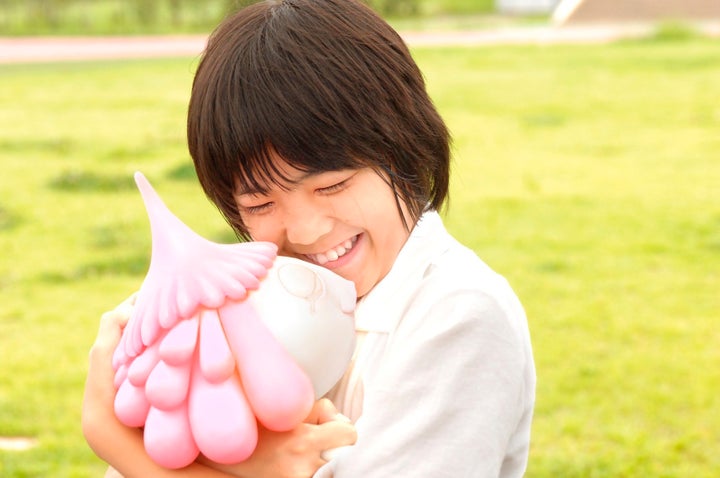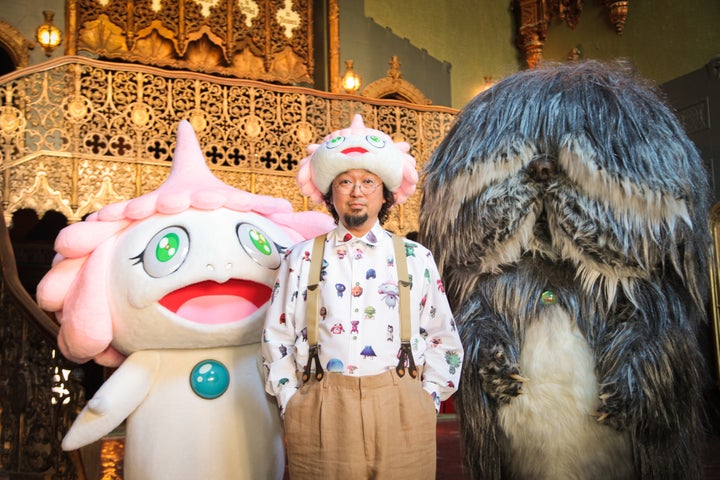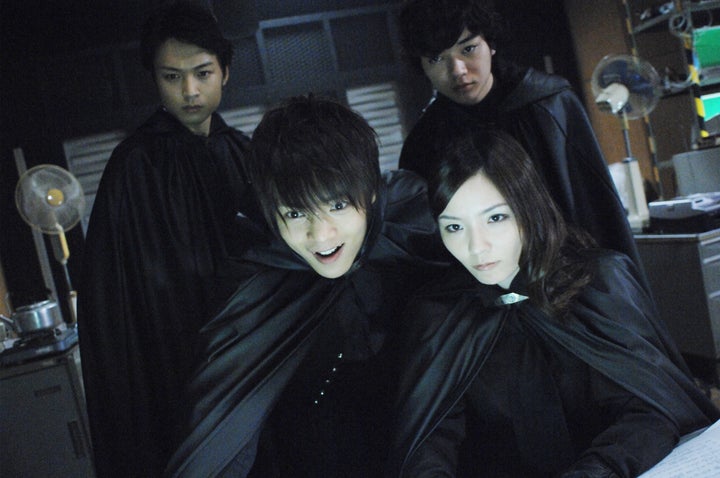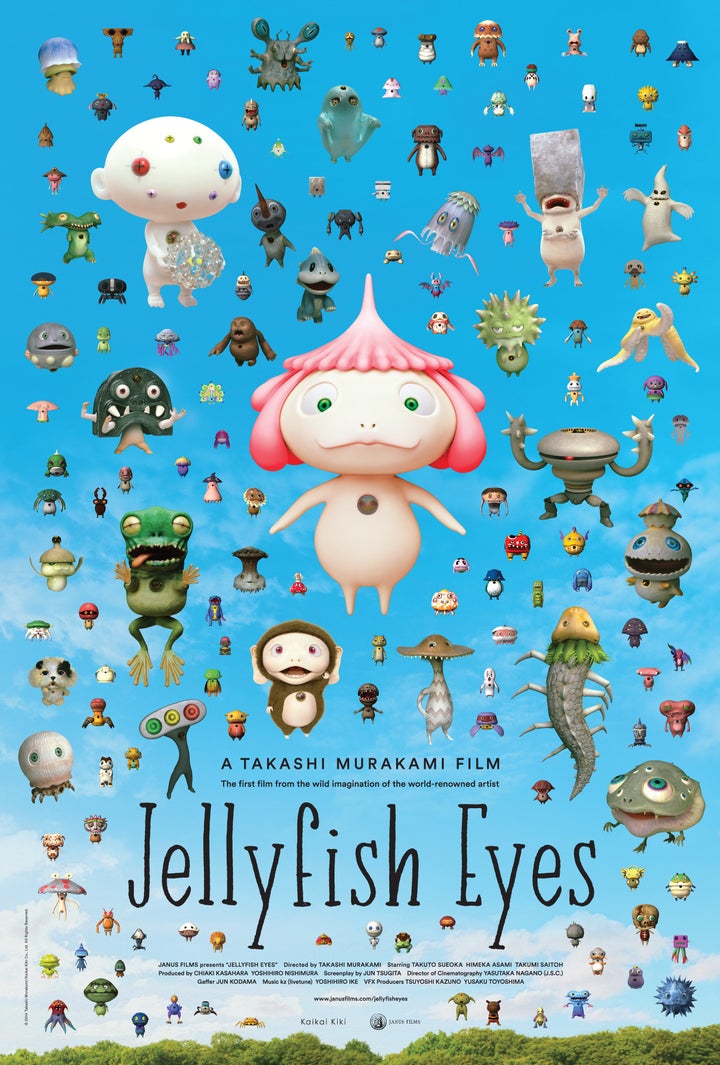
Acclaimed visual artist Takashi Murakami released his debut film, "Jellyfish Eyes," in American theaters last week.
Set in a post-Fukushima Japan, the movie features young children fighting against a a contingent of evil scientists. To do so, they use Pokémon-esque, CGI-animated F.R.I.E.N.D.s. Part imaginary companion, part technological creation, the F.R.I.E.N.D.s are more than just warriors. The titular jellyfish -- Kurage-bo -- provides much needed emotional support to the film's young protagonist, Masashi Kishimoto, who lost his father and his home in the 2011 nuclear disaster.
Political discontent seems to bubble beneath the film's sleek surface. Murakami juxtaposes the starkness of industrial laboratories and a draconian elementary school with the whimsy of sweeping golden fields and the psychedelic F.R.I.E.N.D.s.
The film's American release has prompted the usual storm of repeated media clichés that describe Murakami as the “Japanese Andy Warhol.” He gained the title after critics compared his super-flat aesthetic -- involving the the elimination of high-low divisions in post-war Japan’s cultural hierarchies -- to Warhol's own Pop Art appeal. Held in high esteem by American markets, Murakami has since colloborated with Louis Vuitton, Kanye West and Pharrell Williams, among many others. In 2008, he was named one of Time’s 100 Most Influential People -- the only artist featured.
But with his first feature film, Murakami has left behind the comfort of gallery and celebrity recognition. In many ways, venturing into film is a childhood dream deferred. Murakami had originally wanted to work in animation, which led him to the Tokyo University of the Arts, but once there he pursued a degree in traditional Japanese painting, eventually entering the contemporary art world.
Switching media and intended audience, as he has for the film, is a difficult choice for any acclaimed artist. New endeavors will inevitably be judged by earlier standards, no matter how far they diverge. If reviews have been harsh, it may be because they’re looking for something that "Jellyfish Eyes" does not intend to be: contemporary high art.
When I sat down to interview Murakami, the challenges of this new foray seemed to have worn him down. Though it might have been the mere pressure of days of interviews, he appeared overstretched, almost pained. He’d listen carefully to my questions, then close his eyes, adopt a slight grimace and start to speak. Like a man without sight, his hands stretched out in front of him -- expanding and contracting, working an invisible pizza dough.

From what I’ve gathered, directing an otaku movie is a bit of a childhood dream of yours, and you’ve chosen children as your subject in the movie. Was that intentional? Do you identify with the protagonist?
I did want to make a movie that has a message for children, so that’s why I made a children’s film. I also really like watching films with children as the main characters. I’m working on part two right now, and I use the same child actors. But they are now in junior high school, and I realized that I really wanted to work with child actors of ten to twelve years. That’s what I’ve actually found out by working with actors that are now fourteen or fifteen years old.
What is more appealing to working with younger children than adult actors for you?
I really like the unique way that children look at things, as if they’re not thinking enough or thinking through -- the way they can just go beyond the stories without thinking too much. I love their faces when they’re not perfectly acting. There are child actors who are amazing at acting, and then there are others who are not very great. So you have to really work with them to try to pull things out and trick them into certain things. I actually like the latter better, when you’re working with them, and you film something completely unexpected. The expression comes out that was not expected. I like the uncertainty of those actors.
Your works have historically challenged American ideas about art, but they’ve also been very well received by the high art world. But film is a very different, more populist media. Do you think it’s more or less accessible to an American audience than what you’ve done before?
I really don’t know. But in general I’m better received in America than in Japan. For example with the Vans collaboration I did recently, I was really surprised with how well received it was. So I’m very optimistically hoping that it will be well received.
Why do you think that is -- that you’re received better in America than in Japan?
What I would like to express through my art is how postwar Japan, the defeated Japan, has been morphing into something strange. It’s like painting a self-portrait. This is just my guess, but probably the Japanese audience would feel like, "Oh, we know that. We don’t need to be told by you. We know all of this, and we’re trying to create a positive image. And you’re trying to pile up all these negatives. You don’t need to do that." So maybe that’s why they don’t like me. But for Americans it’s maybe just a very interesting point of view, a different way of looking at things.
I wanted to ask about the film’s opening sequence, which is very intense and metaphysical, and the quote: “In this vast universe, we encounter one another miraculously ...” The film is both lighthearted and childish, but also very intense and profound. Is that related to your idea of the “superflat” -- of not separating the profound and the playful, or the intense and the childish?
This is a children’s film, and you pointed out something very good: that initial message right at the very beginning. When a child watches the film and that message comes up, he wouldn’t know what the hell you’re talking about. The message is really mysterious. But when he or she repeatedly watches fully the film, twice, three times -- then they would want to feel more grownup, more adult. They would try to start thinking about what the message means. The act of trying to understand what it might be saying might link with the self-awareness or the idea of the self. It’s kind of a device I put in there to work that way. So it’s a little bit different from the idea of super-flat, where I’m putting everything together in one plane.
Another thing that’s mixed up in the movie is technology and magic -- which are usually separate stories. But, for instance, the scientist’s experiments are based on “eight ancient rites.” So what’s the significance of putting magic and science together?
I think that those two elements will eventually line up and become one. For example, if you’re watching the movie "Interstellar," theoretically there have to be eleven dimensions otherwise things don’t make sense. But when you try to actually describe more than four dimensions, it’s really difficult, and it becomes more and more fantastical. On the other hand, magic has always been around in history. It hasn’t really gone away. I myself believe in things magical and feng shui. I have a feng shui master who comes and controls things, adjusts things.
When I think about people who can foresee the future or people who can sense danger and warn people -- they’re the people who can sense something that exists in higher dimensions than the fourth dimension. You call that “magic.” But without feeling that, if you’re trying to explain those higher dimensions, you call it science. I think as we go on, slowly they will come together, they will line up, and we will understand them as the same thing. But that’s not very easy to describe. Again, in "Interstellar," in that huge, large-scale movie, they were trying to explain [more than] four dimensions. As for me, I’m trying to tell that story in a children’s film, saying you can believe in this, but also you can believe in that.

I see. There’s a list attached in the press release of films that have influenced you, and I was surprised at how many are American classics: "Lord of the Rings," "Blade Runner," "Star Wars." Though you also listed directors Hayao Miyazaki and Rintaro. Do you feel that American films in particular have had a significant impact on "Jellyfish Eyes"?
My intention was to combine the essence of eighties Spielberg and Spielberg family films with Hayao Miyazaki films. I’m very deeply influenced by American films.
How do you think that those two strands came together in "Jellyfish Eyes"?
I’m not really well versed in this, so it might be wrong. But my sense is that in Hollywood films, the scenarios are really well structured. They’re taught in schools. You have to have a beginning, middle and end.
On the other hand, with Miyazaki films, the way he makes the film is not to complete the whole script and then to make the movie based on that. But to draw each picture by picture. It takes maybe three years. From the very beginning when he draws one picture and gives it to the staff, when they start making the film, to the end, to when he draws the last image -- it will take more than two years. During that time he will be proceeding without knowing where the story is going. From the American point of view, the script seems quite disorganized and it might not feel conclusive. But as an audience, I feel that it’s very alive. It’s very entertaining. And, of course, a Miyazaki film is visually very well done.
But, in the '80s, a B-level movie, like some of the Joe Dante films, were scenario-wise and script-wise, not very conclusive, not very clean. There were a lot of loose ends. Without concluding them cleanly, the ending of the film would be kind of a mess. Of course, the approaches are completely different, but I think there’s something very similar about these two. I really like how the stories don’t close off at the end. I really love that element. I take that in as an influence from both.

Another thing that you mentioned in the director’s statement was that you’re satisfied with the movie because it made you grin. What quality in a film causes that reaction of making you grin?
There’s a scene where Ms. Koko and the jellyfish Kurage-bo are fighting in a game-like setting. When that scene was done with the CGI, when I saw it, I thought: this is it. Because I really wanted to have some of the mood from the Japanese '90s and 2000s fighting games. I wanted to incorporate that into the film and to see how that could be combined with the '80s movies that I was mentioning. And I felt when I saw that scene done in CGI, I felt -- yes, this is it.
You previously collaborated with everyone from Kanye West to Louis Vuitton, but working with a film crew must have been a very different sort of collaboration. Was it hard to merge your artistic intent with everyone else?
Whether it was Kanye West or Louis Vuitton, they understood me as an artist and they wanted to collaborate with me. So it was very easy to work with them. But when it comes to the film, I was the one who wanted to make the film. I knew nothing about it, and the people I was working with didn’t care to collaborate with me -- because of the fact that I didn’t know anything about the film. So they were very, very cool towards me. I really tried to study and learn and absorb everything I could from them, but I also had to convince them that I’m real.
They were really looking down on me the whole time, so the communication was very, very difficult. More than any project I’d done before, it was a challenge. Whether it was the shooting of the live action part, or the post-production CGI, or sound effects, or music. All the people involved would look at me and say, "What is this person talking about?" For each process, I had to start from there and had to convince them. So the whole process was very difficult.
It seems that you’re fairly critical of the Japanese government, especially its nuclear policy. How political or how critical did you want the film to be?
In part two [of the film] I’m actually structuring it so that it looks as though it’s pro-Japanese government. We see that the policy they’re trying to push forward is for something good, for the good of everyone. Then in part three it kind of flips over. But I’m not trying to criticize the government because the government is made up of each one of us. It’s more about if we live irresponsibly, if we didn’t care, this kind of thing could happen. That’s what I want to share with the children. Whether it’s a country or religion, if a group of people are trying to say, "Oh, this is for justice, this is to save everyone, this is for energy," when they have these big ideas and ideologies, that’s when big mistakes can happen. That’s the didactic part of it, and the message that, in the end, I’m trying to convey to the children.
This interview was conducted with the help of a translator. It has been edited and condensed for clarity.

